Kirk
Sailboat specifications
The Kirk is a 35’2” (10.72m) cruising sailboat designed by Henri Amel (France). She was built between 1971 and 1980 by Amel (France) with 276 hulls completed.
Kirk's main features
- Model
- Kirk
- Hull type
- Monohull
- Category
- Cruising sailboat
- Sailboat builder
- Sailboat designer
- Country
- France
- Construction
- Hull and deck: GRP (glass reinforced polyester)
- Number of hulls built
- 276
- First built hull
- 1971
- Last built hull
- 1980
- Appendages
- Keel : L-shaped keel (with bulb)
- Helm
- Single tiller
- Rudder
- Single semi-spade rudder
- Unsinkable
- No
- Trailerable
- No
- Former French navigation category
- 1
- Standard public price ex. VAT (indicative only)
- N/A €
Kirk's main dimensions
- Hull length
- 35’ 2”10.72 m
- Waterline length
- 28’ 2”8.6 m
- Beam (width)
- 9’ 11”3.02 m
- Waterline beam (width)
- 9’ 5”2.85 m
- Draft
- 5’ 4”1.63 m
- Mast height from DWL
- 47’ 11”14.6 m
- Fore freeboard
- 3’ 8”1.13 m
- Mid-ship freeboard
- 2’ 8”0.83 m
- Light displacement (MLC)
- 11023 lb5000 kg
- Maximum displacement (MLDC)
- 14330 lb6500 kg
- Ballast weight
- 4255 lb1930 kg
- Ballast type
- Cast iron
- French customs tonnage
- 9.09 Tx
Kirk's rig and sails
- Upwind sail area
- 570 ft²53 m²
- Downwind sail area
- 989 ft²91.85 m²
- Mainsail area
- 214 ft²19.85 m²
- Genoa area
- 357 ft²33.15 m²
- Jib area
- 184 ft²17.1 m²
- Stormjib area
- 43 ft²4 m²
- Symmetric spinnaker area
- 775 ft²72 m²
- Rigging type
- Sloop Marconi masthead
- Mast configuration
- Deck stepped mast
- Rotating spars
- No
- Number of levels of spreaders
- 1
- Spreaders angle
- 0 °
- Spars construction
- Aluminum spars
- Standing rigging
- 1x19 strand wire continuous
Kirk's performances
- IOR ratingiIOR, or International Offshore Rule, was a measurement rule system used internationally for ocean racing. It allows boats of different sizes and designs to race each other fairly. Therefore, by comparing these values, we can have an indication of the relative speed of 2 boats.
- 25.4
- Upwind sail area to displacementiThe ratio sail area to displacement is obtained by dividing the sail area by the boat's displaced volume to the power two-thirds.
The ratio sail area to displacement can be used to compare the relative sail plan of different sailboats no matter what their size.
Upwind: under 18 the ratio indicates a cruise oriented sailboat with limited performances especially in light wind, while over 25 it indicates a fast sailboat. - 195 ft²/T18.13 m²/T
- Downwind sail area to displacementiThe ratio sail area to displacement is obtained by dividing the sail area by the boat's displaced volume to the power two-thirds.
The ratio sail area to displacement can be used to compare the relative sail plan of different sailboats no matter what their size. - 338 ft²/T31.41 m²/T
- Displacement-length ratio (DLR)iThe Displacement Length Ratio (DLR) is a figure that points out the boat's weight compared to its waterline length. The DLR is obtained by dividing the boat's displacement in tons by the cube of one one-hundredth of the waterline length (in feet).
The DLR can be used to compare the relative mass of different sailboats no matter what their length:
a DLR less than 180 is indicative of a really light sailboat (race boat made for planning), while a DLR greater than 300 is indicative of a heavy cruising sailboat. - 223
- Ballast ratioiThe Ballast ratio is an indicator of stability; it is obtained by dividing the boat's displacement by the mass of the ballast. Since the stability depends also of the hull shapes and the position of the center of gravity, only the boats with similar ballast arrangements and hull shapes should be compared.
The higher the ballast ratio is, the greater is the stability. - 39 %
- Wetted area
- 296 ft²27.52 m²
- Maximum transverse section
- 17 ft²1.55 m²
- Critical hull speediAs a ship moves in the water, it creates standing waves that oppose its movement. This effect increases dramatically the resistance when the boat reaches a speed-length ratio (speed-length ratio is the ratio between the speed in knots and the square root of the waterline length in feet) of about 1.2 (corresponding to a Froude Number of 0.35) . This very sharp rise in resistance, between speed-length ratio of 1.2 to 1.5, is insurmountable for heavy sailboats and so becomes an apparent barrier. This leads to the concept of "hull speed".
The hull speed is obtained by multiplying the square root of the waterline length (in feet) by 1.34. - 7.12 knots
Kirk's auxiliary engine
- Engine(s)
- 1 inboard engine
- Engine(s) power (min./max.)
- 15 HP / 25 HP
- Fuel type
- Diesel
Kirk's accommodations and layout
- Cockpit
- Center cockpit
- Cabin(s)
- 2
- Berth(s) (min./max.)
- 6 / 7
- Head(s)
- 1
- Freshwater tank capacity
- 66 gal250 liters
- Maximum headroom
- 5’ 11”1.8 m
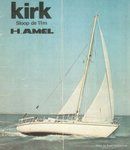
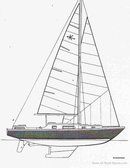

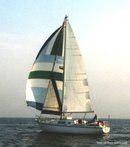


Amel Kirk interior and accommodations - - 5/9
Picture extracted from the commercial documentation © Amel
Picture extracted from the commercial documentation © Amel
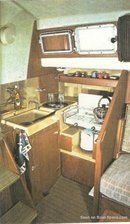

Amel Kirk interior and accommodations - - 6/9
Picture extracted from the commercial documentation © Amel
Picture extracted from the commercial documentation © Amel


Amel Kirk interior and accommodations - - 7/9
Picture extracted from the commercial documentation © Amel
Picture extracted from the commercial documentation © Amel


Amel Kirk interior and accommodations - - 8/9
Picture extracted from the commercial documentation © Amel
Picture extracted from the commercial documentation © Amel
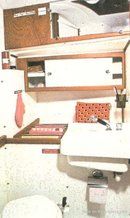

Amel Kirk interior and accommodations - - 9/9
Picture extracted from the commercial documentation © Amel
Picture extracted from the commercial documentation © Amel
Similar sailboats that may interest you:
Sailboats
First built hull
Hull length
1988
52’ 6”16 m
2007
38’ 1”11.6 m
1981
32’ 5”9.87 m
1970
33’ 8”10.26 m
1985
32’ 10”10 m
1979
33’10.06 m
1977
36’10.97 m
1985
32’ 10”10 m
2017
32’ 10”9.99 m
2014
32’ 8”9.98 m
2014
32’ 10”9.99 m
2005
33’ 11”10.32 m
2004
34’ 1”10.38 m
1996
35’ 5”10.8 m
1994
37’ 1”11.31 m